The Role of Spatial Variability in Developing Cycling Cities: Implications Drawn from Geographically Weighted Regressions
Abstract
Highlights
- A multiple geographically weighted regression (GWR) approach shows that cycling use in cities is not uniform, and the effects of distance and precipitation on cycling vary across different locations. While the relationship between cycling volume and distance and precipitation remains negative, some locations are less sensitive to these effects.
- Cycling volumes in New Zealand’s largest city of Auckland show lower sensitivity to distance compared with Wellington and Christchurch, suggesting that urban design plays a role in cycling behavior. In addition, cycling volumes in Christchurch show the highest sensitivity to precipitation despite having the lowest annual rainfall of the three cities.
- Improving infrastructure to connect to central economic nodes, rather than solely the central business district, will help mitigate the impact of distance on cycling, encouraging the use of cycling as an alternative transport option.
- Prioritize the development of weather-resistant cycling infrastructure to remove barriers related to weather by including features such as covered bike lanes, rain shelters, and real-time weather updates to help cyclists on their trip.
Abstract
1. Introduction
2. Literature
2.1. Urban Planning and Development
2.2. Transport and Safety
2.3. Other Factors
2.4. Methods and Data
3. Data and Methodology
3.1. Data
3.2. Methodology
4. Results
5. Discussion
5.1. Spatial Variability Mechanisms
5.2. Implications
6. Conclusions
Author Contributions
Funding
Institutional Review Board Statement
Informed Consent Statement
Data Availability Statement
Conflicts of Interest
References
- Oviedo, D.; Sabogal-Cardona, O. Arguments for Cycling as a Mechanism for Sustainable Modal Shifts in Bogotá. J. Transp. Geogr. 2022, 99, 103291. [Google Scholar] [CrossRef]
- Nankervis, M. The Effect of Weather and Climate on Bicycle Commuting. Transp. Res. Part A Policy Pract. 1999, 33, 417–431. [Google Scholar] [CrossRef]
- An, R.; Zahnow, R.; Pojani, D.; Corcoran, J. Weather and Cycling in New York: The Case of Citibike. J. Transp. Geogr. 2019, 77, 97–112. [Google Scholar] [CrossRef]
- Schneider, F.; Jensen, A.F.; Daamen, W.; Hoogendoorn, S. Empirical Analysis of Cycling Distances in Three of Europe’s Most Bicycle-Friendly Regions within an Accessibility Framework. Int. J. Sustain. Transp. 2023, 17, 775–789. [Google Scholar] [CrossRef]
- Wardman, M.; Tight, M.; Page, M. Factors Influencing the Propensity to Cycle to Work. Transp. Res. Part A Policy Pract. 2007, 41, 339–350. [Google Scholar] [CrossRef]
- Tyndall, J. Cycling Mode Choice amongst US Commuters: The Role of Climate and Topography. Urban Stud. 2022, 59, 97–119. [Google Scholar] [CrossRef]
- Howard, C.; Burns, E.K. Cycling to Work in Phoenix: Route Choice, Travel Behavior, and Commuter Characteristics. Transp. Res. Rec. J. Transp. Res. Board 2001, 1773, 39–46. [Google Scholar] [CrossRef]
- Goodman, A.; Sahlqvist, S.; Ogilvie, D. Who Uses New Walking and Cycling Infrastructure and How? Longitudinal Results from the UK IConnect Study. Prev. Med. 2013, 57, 518–524. [Google Scholar] [CrossRef]
- Sun, Y.; Mobasheri, A.; Hu, X.; Wang, W. Investigating Impacts of Environmental Factors on the Cycling Behavior of Bicycle-Sharing Users. Sustainability 2017, 9, 1060. [Google Scholar] [CrossRef]
- Wilson, O.; Vairo, N.; Bopp, M.; Sims, D.; Dutt, K.; Pinkos, B. Best Practices for Promoting Cycling amongst University Students and Employees. J. Transp. Health 2018, 9, 234–243. [Google Scholar] [CrossRef]
- Pucher, J.; Buehler, R. Safer Cycling Through Improved Infrastructure. Am. J. Public Health 2016, 106, 2089–2091. [Google Scholar] [CrossRef] [PubMed]
- Çiriş, S.; Akay, M.; Tümer, E. Investigating the Influence of Spatial Characteristics on Cycling Volume: A Multi-Scale Geographic Weighted Regression Approach. Transp. Res. Interdiscip. Perspect. 2024, 26, 101160. [Google Scholar] [CrossRef]
- Munira, S.; Sener, I.N. A Geographically Weighted Regression Model to Examine the Spatial Variation of the Socioeconomic and Land-Use Factors Associated with Strava Bike Activity in Austin, Texas. J. Transp. Geogr. 2020, 88, 102865. [Google Scholar] [CrossRef]
- Schmiedeskamp, P.; Zhao, W. Estimating Daily Bicycle Counts in Seattle, Washington, from Seasonal and Weather Factors. Transp. Res. Rec. J. Transp. Res. Board 2016, 2593, 94–102. [Google Scholar] [CrossRef]
- Miranda-Moreno, L.F.; Nosal, T.; Schneider, R.J.; Proulx, F. Classification of Bicycle Traffic Patterns in Five North American Cities. Transp. Res. Rec. J. Transp. Res. Board 2013, 2339, 68–79. [Google Scholar] [CrossRef]
- Chen, P.; Zhou, J.; Sun, F. Built Environment Determinants of Bicycle Volume: A Longitudinal Analysis. J. Transp. Land Use 2017, 10, 655–674. [Google Scholar] [CrossRef]
- Lv, H.; Li, H.; Sze, N.N.; Zhang, Z.; Ren, G.; Zhang, Y. Analysis of Factors Influencing Cycling Count: A Micro-Level Study Using Road Segment Count Data in London. Int. J. Sustain. Transp. 2023, 17, 1113–1128. [Google Scholar] [CrossRef]
- Jean-Louis, G.; Eckhardt, M.; Podschun, S.; Mahnkopf, J.; Venohr, M. Estimating Daily Bicycle Counts with Strava Data in Rural and Urban Locations. Travel Behav. Soc. 2024, 34, 100694. [Google Scholar] [CrossRef]
- NZ Transport Agency Waka Kotahi Urban Cycleways Programme. Available online: https://www.nzta.govt.nz/walking-cycling-and-public-transport/cycling/investing-in-cycling/urban-cycleways-programme?start=0 (accessed on 14 August 2024).
- Ministry for the Environment. Te Hau Mārohi Ki Anamata: Towards a Productive, Sustainable and Inclusive Economy: Aotearoa New Zealand’s First Emissions Reduction Plan; Ministry for the Environment Manatu Mo Te Taiao: Wellington, New Zealand, 2022; ISBN 9781991025265.
- Keall, M.D.; Shaw, C.; Chapman, R.; Howden-Chapman, P. Reductions in Carbon Dioxide Emissions from an Intervention to Promote Cycling and Walking: A Case Study from New Zealand. Transp. Res. D Transp. Environ. 2018, 65, 687–696. [Google Scholar] [CrossRef]
- Aldy, J.E.; Pizer, W.A.; Akimoto, K. Climate Policy Comparing Emissions Mitigation Efforts across Countries Comparing Emissions Mitigation Efforts across Countries. Cent. Glob. Dev. Work. Pap. 2016, 17, 501–515. [Google Scholar] [CrossRef]
- Bhowmick, D.; Saberi, M.; Stevenson, M.; Thompson, J.; Winters, M.; Nelson, T.; Leao, S.Z.; Seneviratne, S.; Pettit, C.; Vu, H.L.; et al. A Systematic Scoping Review of Methods for Estimating Link-Level Bicycling Volumes. Transp. Rev. 2023, 43, 622–651. [Google Scholar] [CrossRef]
- Zare, P.; Leao, S.; Gudes, O.; Pettit, C. A Simple Agent-Based Model for Planning for Bicycling: Simulation of Bicyclists’ Movements in Urban Environments. Comput. Environ. Urban Syst. 2024, 108, 102059. [Google Scholar] [CrossRef]
- Yang, Y.; Wu, X.; Zhou, P.; Gou, Z.; Lu, Y. Towards a Cycling-Friendly City: An Updated Review of the Associations between Built Environment and Cycling Behaviors (2007–2017). J. Transp. Health 2019, 14, 100613. [Google Scholar] [CrossRef]
- Moustaka, V.; Vakali, A.; Anthopoulos, L.G. A Systematic Review for Smart City Data Analytics. ACM Comput. Surv. 2019, 51, 1–41. [Google Scholar] [CrossRef]
- Borsekova, K.; Vanova, A.; Vitalisova, K. The Power of Communities in Smart Urban Development. Procedia Soc. Behav. Sci. 2016, 223, 51–57. [Google Scholar] [CrossRef]
- Kandt, J.; Batty, M. Smart Cities, Big Data and Urban Policy: Towards Urban Analytics for the Long Run. Cities 2021, 109, 102992. [Google Scholar] [CrossRef]
- Dyason, D.; Fieger, P.; Rice, J. Greened Shopping Spaces and Pedestrian Shopping Interactions: The Case of Christchurch. Int. J. Tour. Cities 2024, 10, 1247–1265. [Google Scholar] [CrossRef]
- Yigitcanlar, T. Smart Cities: An Effective Urban Development and Management Model? Aust. Plan. 2015, 52, 27–34. [Google Scholar] [CrossRef]
- Hou, Q.; Li, W.; Zhang, X.; Fang, Y.; Duan, Y.; Zhang, L.; Liu, W. Intelligent Urban Planning on Smart City Blocks Based on Bicycle Travel Data Sensing. Comput. Commun. 2020, 153, 26–33. [Google Scholar] [CrossRef]
- Pucher, J.; Buehler, R. Making Cycling Irresistible: Lessons from The Netherlands, Denmark and Germany. Transp. Rev. 2008, 28, 495–528. [Google Scholar] [CrossRef]
- Lopes, M.; Mélice Dias, A.; Silva, C. The Impact of Urban Features in Cycling Potential—A Tale of Portuguese Cities. J. Transp. Geogr. 2021, 95, 103149. [Google Scholar] [CrossRef]
- Goel, R.; Goodman, A.; Aldred, R.; Nakamura, R.; Martin, L.; Garcia, T.; Zapata-Diomedi, B.; Herick De Sa, T.; Tiwari, G.; De Nazelle, A.; et al. Cycling Behaviour in 17 Countries across 6 Continents: Levels of Cycling, Who Cycles, for What Purpose, and How Far? Transp. Rev. 2021, 42, 58–81. [Google Scholar] [CrossRef]
- Hull, A.; O’Holleran, C. Bicycle Infrastructure: Can Good Design Encourage Cycling? Urban Plan. Transp. Res. 2014, 2, 369–406. [Google Scholar] [CrossRef]
- Pucher, J.; Buehler, R. Cycling towards a More Sustainable Transport Future. Transp. Rev. 2017, 37, 689–694. [Google Scholar] [CrossRef]
- Carvajal, G.A.; Sarmiento, O.L.; Medaglia, A.L.; Cabrales, S.; Rodríguez, D.A.; Quistberg, D.A.; López, S. Bicycle Safety in Bogotá: A Seven-Year Analysis of Bicyclists’ Collisions and Fatalities. Accid. Anal. Prev. 2020, 144, 105596. [Google Scholar] [CrossRef]
- Gössling, S.; McRae, S. Subjectively Safe Cycling Infrastructure: New Insights for Urban Designs. J. Transp. Geogr. 2022, 101, 103340. [Google Scholar] [CrossRef]
- Pasha, M.; Rifaat, S.; Tay, R.; De Barros, A. Urban Design and Planning Influences on the Share of Trips Taken by Cycling. J. Urban Des. 2016, 21, 471–480. [Google Scholar] [CrossRef]
- Nosal, T.; Miranda-Moreno, L.F. The Effect of Weather on the Use of North American Bicycle Facilities: A Multi-City Analysis Using Automatic Counts. Transp. Res. Part A Policy Pract. 2014, 66, 213–225. [Google Scholar] [CrossRef]
- Levy, N.; Golani, C.; Ben-Elia, E. An Exploratory Study of Spatial Patterns of Cycling in Tel Aviv Using Passively Generated Bike-Sharing Data. J. Transp. Geogr. 2019, 76, 325–334. [Google Scholar] [CrossRef]
- Lee, K.; Sener, I.N. Emerging Data for Pedestrian and Bicycle Monitoring: Sources and Applications. Transp. Res. Interdiscip. Perspect. 2020, 4, 100095. [Google Scholar] [CrossRef]
- Dadashova, B.; Griffin, G.P.; Das, S.; Turner, S.; Sherman, B. Estimation of Average Annual Daily Bicycle Counts Using Crowdsourced Strava Data. Transp. Res. Rec. J. Transp. Res. Board 2020, 2674, 390–402. [Google Scholar] [CrossRef]
- Fishman, E.; Washington, S.; Haworth, N. Bike Share: A Synthesis of the Literature. Transp. Rev. 2013, 33, 148–165. [Google Scholar] [CrossRef]
- Kaltenbrunner, A.; Meza, R.; Grivolla, J.; Codina, J.; Banchs, R. Urban Cycles and Mobility Patterns: Exploring and Predicting Trends in a Bicycle-Based Public Transport System. Pervasive Mob. Comput. 2010, 6, 455–466. [Google Scholar] [CrossRef]
- Lathia, N.; Ahmed, S.; Capra, L. Measuring the Impact of Opening the London Shared Bicycle Scheme to Casual Users. Transp. Res. Part C Emerg. Technol. 2012, 22, 88–102. [Google Scholar] [CrossRef]
- Zhang, Y.; Thomas, T.; Brussel, M.; van Maarseveen, M. Exploring the Impact of Built Environment Factors on the Use of Public Bikes at Bike Stations: Case Study in Zhongshan, China. J. Transp. Geogr. 2017, 58, 59–70. [Google Scholar] [CrossRef]
- Tran, T.D.; Ovtracht, N.; D’Arcier, B.F. Modeling Bike Sharing System Using Built Environment Factors. Procedia CIRP 2015, 30, 293–298. [Google Scholar] [CrossRef]
- Singhvi, D.; Singhvi, S.; Frazier, P.I.; Henderson, S.G.; O’ Mahony, E.; Shmoys, D.B.; Woodard, D.B. Predicting Bike Usage for New York City’s Bike Sharing System. AAAI Workshop Comput. Sustain. 2015, 110–114. [Google Scholar]
- Lin, J.J.; Zhao, P.; Takada, K.; Li, S.; Yai, T.; Chen, C.H. Built Environment and Public Bike Usage for Metro Access: A Comparison of Neighborhoods in Beijing, Taipei, and Tokyo. Transp. Res. D Transp. Environ. 2018, 63, 209–221. [Google Scholar] [CrossRef]
- Kou, Z.; Cai, H. Understanding Bike Sharing Travel Patterns: An Analysis of Trip Data from Eight Cities. Phys. A Stat. Mech. Its Appl. 2019, 515, 785–797. [Google Scholar] [CrossRef]
- Vogel, P.; Greiser, T.; Mattfeld, D.C. Understanding Bike-Sharing Systems Using Data Mining: Exploring Activity Patterns. Procedia Soc. Behav. Sci. 2011, 20, 514–523. [Google Scholar] [CrossRef]
- Yang, H.; Lu, X.; Cherry, C.; Liu, X.; Li, Y. Spatial Variations in Active Mode Trip Volume at Intersections: A Local Analysis Utilizing Geographically Weighted Regression. J. Transp. Geogr. 2017, 64, 184–194. [Google Scholar] [CrossRef]
- Bao, J.; Shi, X.; Zhang, H. Spatial Analysis of Bikeshare Ridership with Smart Card and POI Data Using Geographically Weighted Regression Method. IEEE Access 2018, 6, 76049–76059. [Google Scholar] [CrossRef]
- Wei, Z.; Zhen, F.; Mo, H.; Wei, S.; Peng, D.; Zhang, Y. Travel Behaviours of Sharing Bicycles in the Central Urban Area Based on Geographically Weighted Regression: The Case of Guangzhou, China. Chin. Geogr. Sci. 2021, 31, 54–69. [Google Scholar] [CrossRef]
- Wellington City Council Cycle Count Data. Available online: https://www.transportprojects.org.nz/cycle-data (accessed on 3 December 2024).
- Christchurch City Council Cycle Counters. Available online: https://smartview.ccc.govt.nz/data/cycle-counters (accessed on 3 December 2024).
- Auckland Transport Monthly Cycle Monitoring. Available online: https://at.govt.nz/cycling-walking/research-monitoring/monthly-cycle-monitoring (accessed on 3 December 2024).
- Coetzee, C.; Dyason, D. Cycling Activity in New Zealand’s Three Largest Cities; Dataset; Lincoln University: Lincoln, New Zealand, 2025. [Google Scholar] [CrossRef]
- Lu, B.; Charlton, M.; Harris, P.; Fotheringham, A.S. Geographically Weighted Regression with a Non-Euclidean Distance Metric: A Case Study Using Hedonic House Price Data. Int. J. Geogr. Inf. Sci. 2014, 28, 660–681. [Google Scholar] [CrossRef]
- Zheng, B.; Lin, X.; Yin, D.; Qi, X. Does Tobler’s First Law of Geography Apply to Internet Attention? A Case Study of the Asian Elephant Northern Migration Event. PLoS ONE 2023, 18, e0282474. [Google Scholar] [CrossRef]
- Páez, A.; Wheeler, D.C. Geographically Weighted Regression. In International Encyclopedia of Human Geography; Elsevier: Amsterdam, The Netherlands, 2009; pp. 407–414. [Google Scholar]
- Fotheringham, A.S.; Brunsdon, C. Local Forms of Spatial Analysis. Geogr. Anal. 1999, 31, 340–358. [Google Scholar] [CrossRef]
- Fotheringham, A.S.; Brunsdon, C.; Charlton, M. Geographically Weighted Regression: The Analysis of Spatially Varying Relationships; John Wiley & Sons Ltd.: West Sussex, UK, 2002. [Google Scholar]
- Faka, A.; Kalogeropoulos, K.; Chalkias, C. Quality of Life in Athens, Greece, Using Geonformatics. In Geoinformatics for Geosciences; Elsevier: Amsterdam, The Netherlands, 2023; pp. 31–44. [Google Scholar]
- Mendez, C. Geographically Weighted Regression Models: A Tutorial Using the Spgwr Package in R 2020. Available online: https://rpubs.com/quarcs-lab/tutorial-gwr1 (accessed on 3 February 2025).
- Thomas, T.; Jaarsma, R.; Tutert, B.; Thomas, T.; Tutert, Á.B.; Tutert, B.; Jaarsma, R. Exploring Temporal Fluctuations of Daily Cycling Demand on Dutch Cycle Paths: The Influence of Weather on Cycling. Transportation 2013, 40, 1–22. [Google Scholar] [CrossRef]
- Broach, J.; Dill, J.; Gliebe, J. Where Do Cyclists Ride? A Route Choice Model Developed with Revealed Preference GPS Data. Transp. Res. Part A Policy Pract. 2012, 46, 1730–1740. [Google Scholar] [CrossRef]
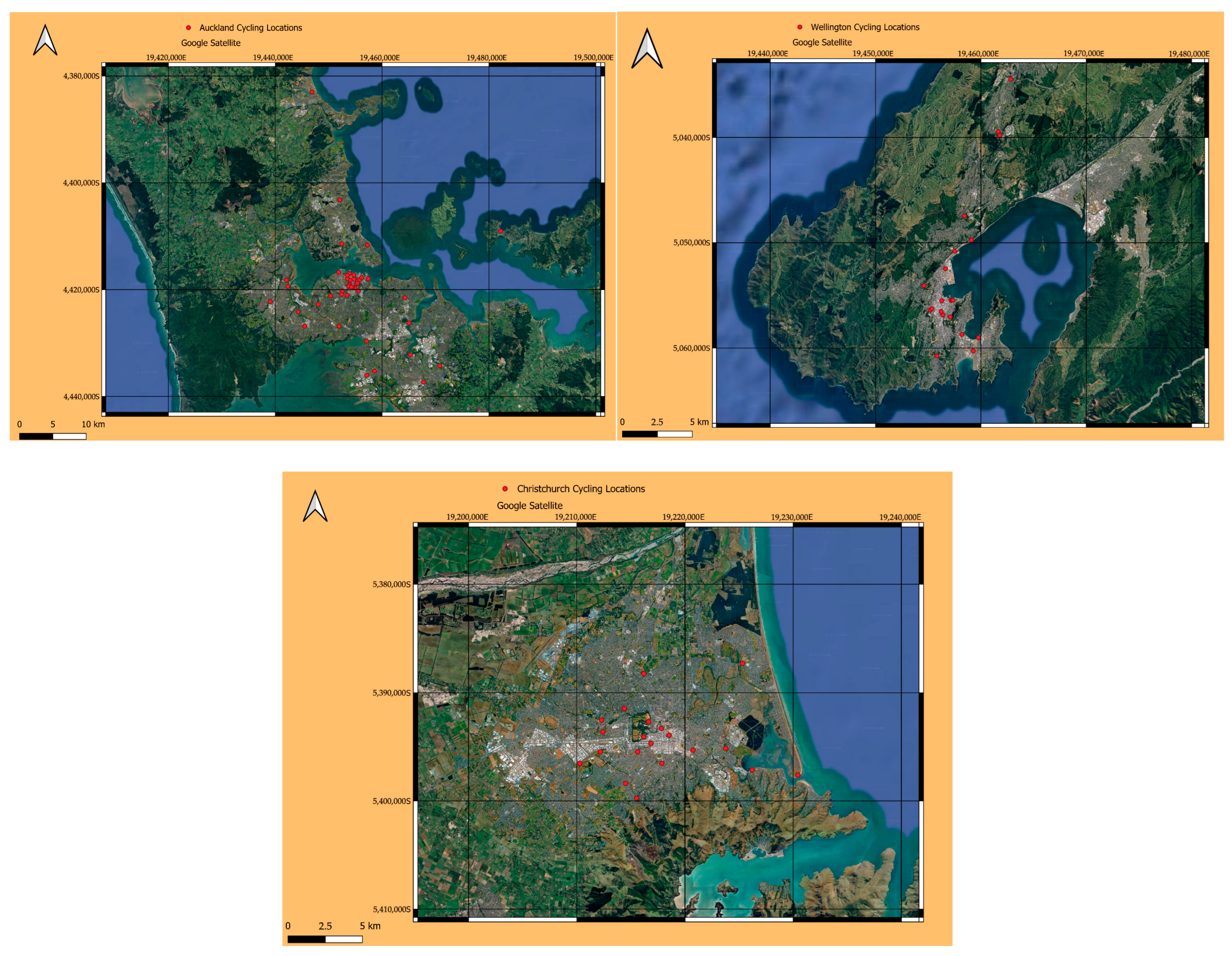


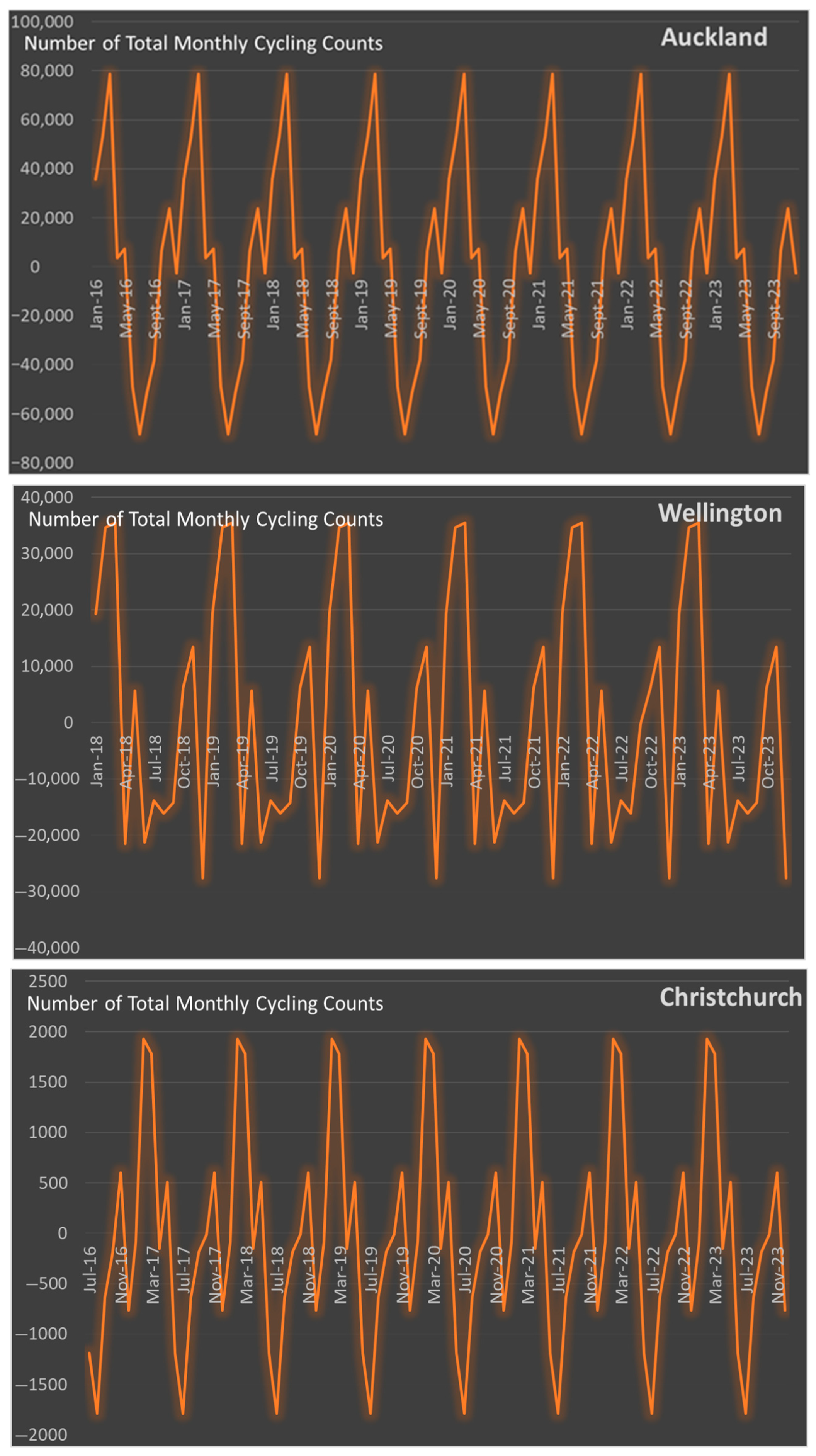
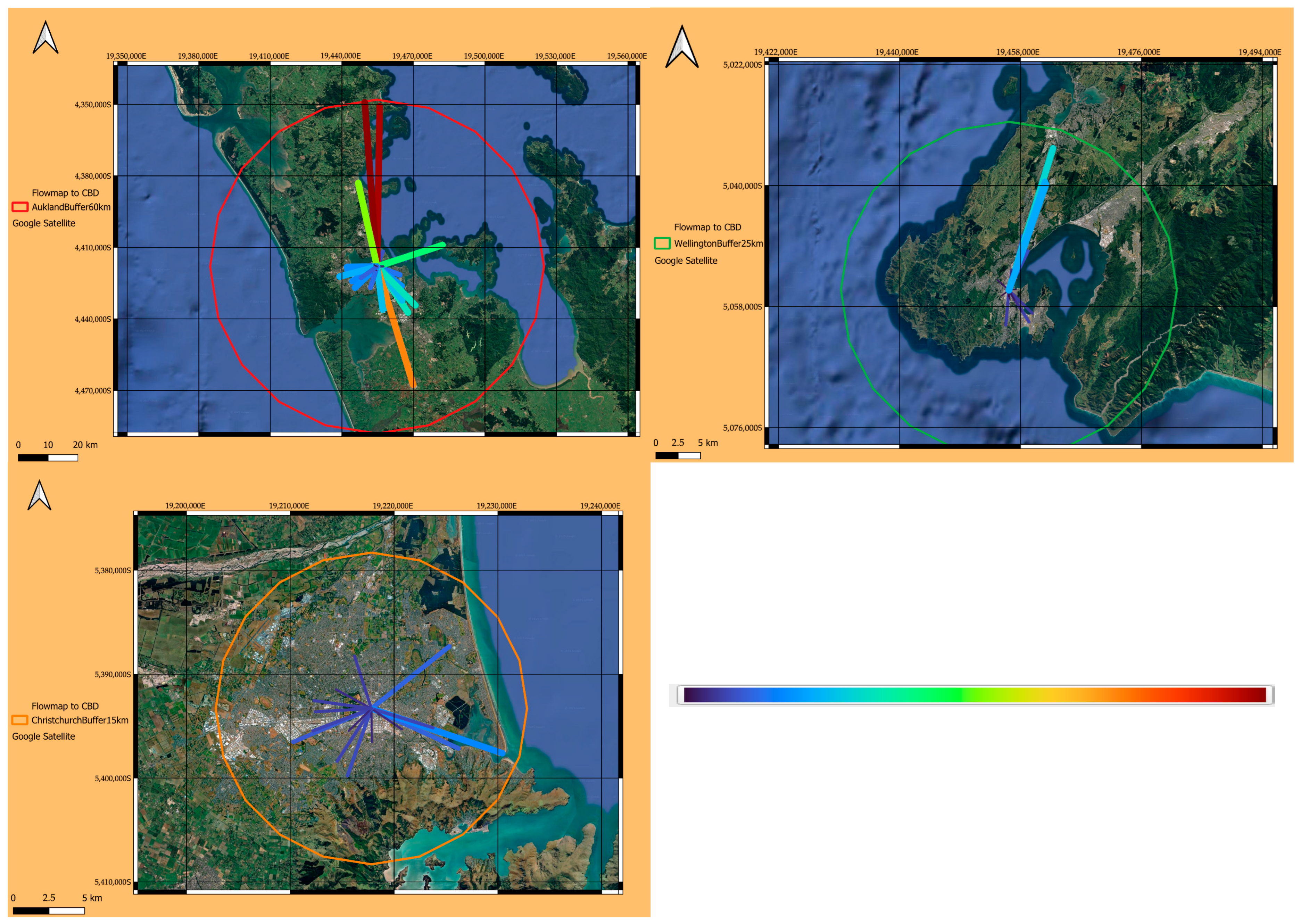


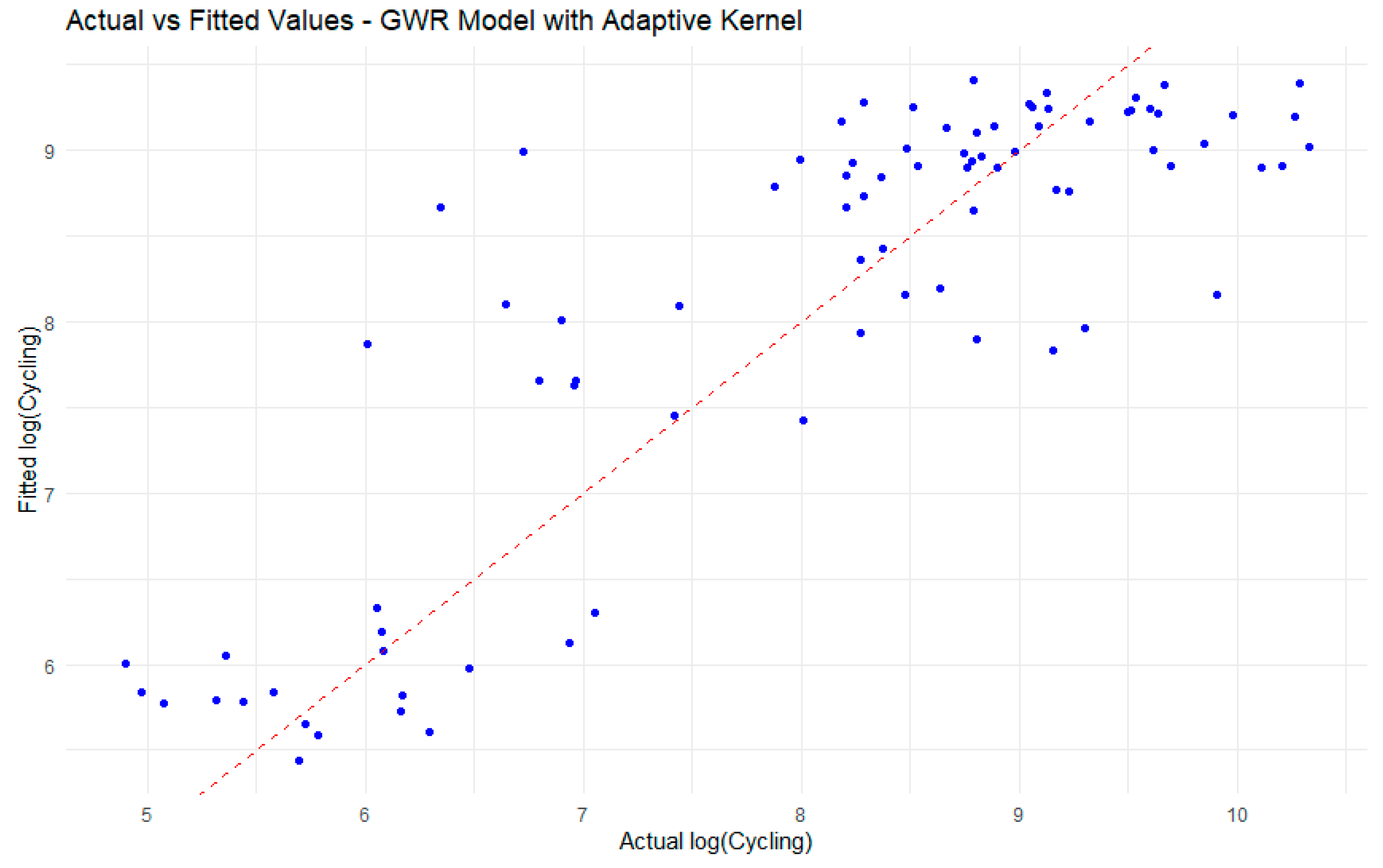
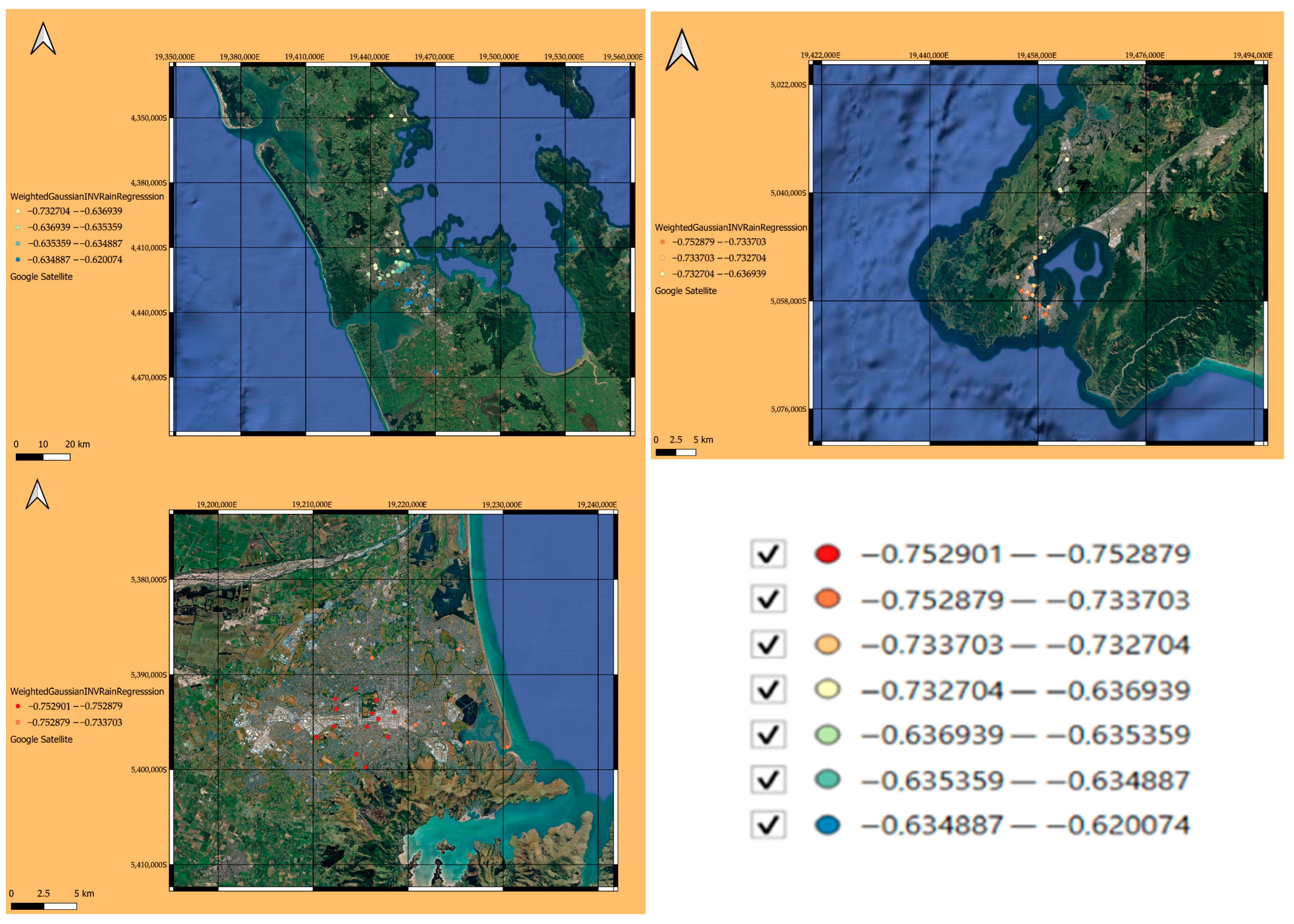
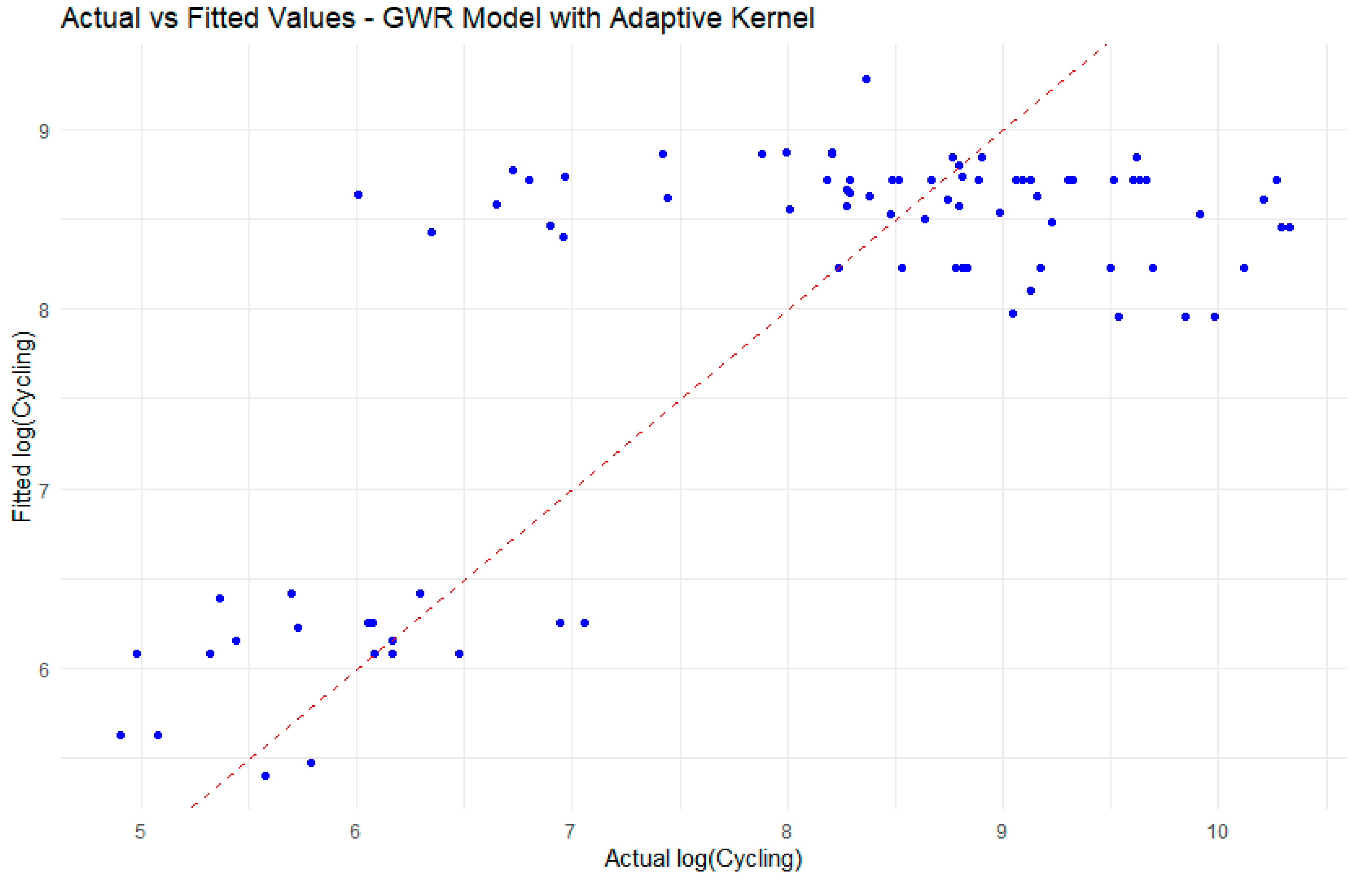
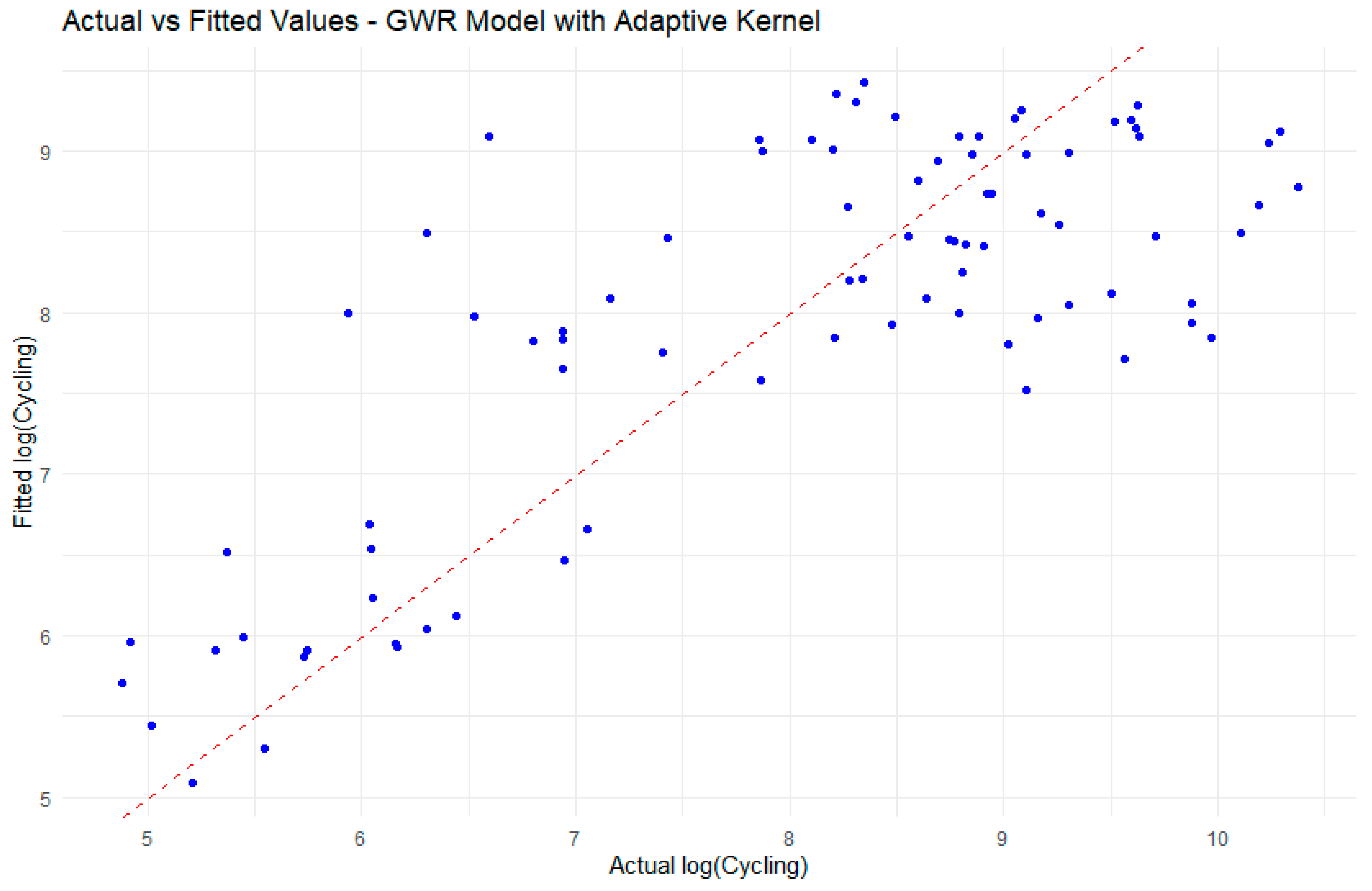
| City | Auckland | Wellington | Christchurch | Auckland | Wellington | Christchurch |
|---|---|---|---|---|---|---|
| Month | Total Count per Month | Median Count per Month | ||||
| January | 3,289,453 | 1,386,538 | 54,581 | 411,115 | 230,768 | 7566 |
| February | 3,429,323 | 1,480,812 | 68,800 | 410,387 | 260,650 | 9927 |
| March | 3,633,386 | 1,478,777 | 67,863 | 456,020 | 246,945 | 9570 |
| April | 3,077,866 | 1,130,454 | 54,449 | 387,508 | 194,011 | 7686 |
| May | 3,071,617 | 1,282,520 | 59,179 | 378,119 | 222,048 | 8705 |
| June | 2,615,713 | 1,128,700 | 52,900 | 327,455 | 193,236 | 6518 |
| July | 2,465,492 | 1,164,449 | 48,869 | 312,634 | 205,316 | 6156 |
| August | 2,592,755 | 1,157,315 | 57,840 | 320,265 | 199,481 | 7234 |
| September | 2,736,734 | 1,171,510 | 61,250 | 350,228 | 196,059 | 7755 |
| October | 3,046,320 | 1,295,054 | 63,577 | 363,378 | 219,536 | 7833 |
| November | 3,211,119 | 1,334,883 | 68,768 | 384,604 | 223,711 | 8820 |
| December | 2,975,093 | 1,104,424 | 57,339 | 369,982 | 181,174 | 7388 |
| Km Buffer Zone (Average) | Auckland | Wellington | Christchurch |
|---|---|---|---|
| 1 | 2 | 2 | 1 |
| 2 | 12 | 7 | 3 |
| 3 | 2 | 3 | 0 |
| 5 | 4 | 4 | 4 |
| 10 | 5 | 4 | 10 |
| 20 | 11 | 2 | 1 |
| 30 | 3 | 1 | 0 |
| 60 | 5 | 0 | 0 |
| Km Buffer Zone (Average) | Auckland | Wellington | Christchurch |
|---|---|---|---|
| 1 | 122,028 | 23,720 | 3377 |
| 2 | 63,853 | 36,146 | 8183 |
| 3 | 148,098 | 45,340 | 0 |
| 5 | 58,509 | 95,774 | 2536 |
| 10 | 28,515 | 52,013 | 2048 |
| 20 | 26,880 | 18,539 | 2465 |
| 30 | 22,810 | 24,902 | 0 |
| 60 | 86,908 | 0 | 0 |
| Summary of GWR Coefficient Estimates at Data Points: | ||||||
|---|---|---|---|---|---|---|
| Min. | 1st Qu. | Median | 3rd Qu. | Max. | Global OLS | |
| X.Intercept | 16.36919 | 16.83108 | 21.15939 | 29.48614 | 29.91027 | 29.3990 |
| lndistance | −0.57291 | −0.57218 | −0.55913 | −0.47291 | −0.47238 | −0.4999 |
| inrlnrain | −97.63208 | −95.59559 | −56.21138 | −35.65933 | −33.47125 | −95.2342 |
Disclaimer/Publisher’s Note: The statements, opinions and data contained in all publications are solely those of the individual author(s) and contributor(s) and not of MDPI and/or the editor(s). MDPI and/or the editor(s) disclaim responsibility for any injury to people or property resulting from any ideas, methods, instructions or products referred to in the content. |
© 2025 by the authors. Licensee MDPI, Basel, Switzerland. This article is an open access article distributed under the terms and conditions of the Creative Commons Attribution (CC BY) license (https://creativecommons.org/licenses/by/4.0/).
Share and Cite
Dyason, D.; Coetzee, C.E.; Kleynhans, E. The Role of Spatial Variability in Developing Cycling Cities: Implications Drawn from Geographically Weighted Regressions. Smart Cities 2025, 8, 133. https://doi.org/10.3390/smartcities8040133
Dyason D, Coetzee CE, Kleynhans E. The Role of Spatial Variability in Developing Cycling Cities: Implications Drawn from Geographically Weighted Regressions. Smart Cities. 2025; 8(4):133. https://doi.org/10.3390/smartcities8040133
Chicago/Turabian StyleDyason, David, Clive Egbert Coetzee, and Ewert Kleynhans. 2025. "The Role of Spatial Variability in Developing Cycling Cities: Implications Drawn from Geographically Weighted Regressions" Smart Cities 8, no. 4: 133. https://doi.org/10.3390/smartcities8040133
APA StyleDyason, D., Coetzee, C. E., & Kleynhans, E. (2025). The Role of Spatial Variability in Developing Cycling Cities: Implications Drawn from Geographically Weighted Regressions. Smart Cities, 8(4), 133. https://doi.org/10.3390/smartcities8040133





